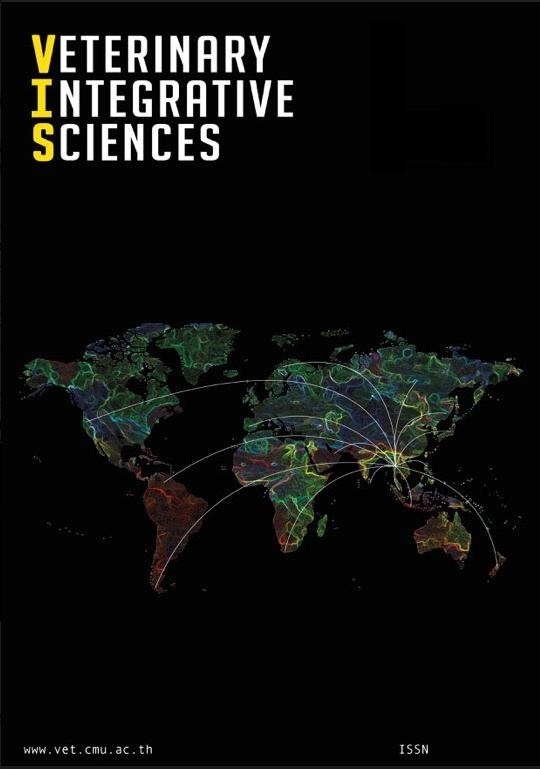Investigation of serum interleukin-8 level and clinicopathological parameters in canine mammary gland tumor patients
Main Article Content
Abstract
This study aimed to evaluate serum interleukin-8 (IL-8) levels in female dogs with mammary gland tumors and the correlation of these levels with clinicopathological parameters. Serum IL-8 levels from 25 female dogs with mammary gland tumors and 10 healthy intact female dogs were measured using canine IL-8 ELISA test kit. The animal age varied from 6 to 16 years (median = 10.5 years), with 36% (n=9) dogs under 10 years 64% (n=16) over 10 years. Thirty-two percentage of dogs (n=8) with mammary gland tumors presented with a tumor up to 6 months, 36% (n=9) between 6 months and 12 months and 32% (n=8) for greater than 12 months. Stage II (56%) tumors were the most classification, followed by stage I (16%), stage III (16%), and stage V, 12% (n=3). Among the tumor tissues, 3 samples (12%) were hyperplasia, 9 samples (36%) were benign mixed tumor and 13 samples (52%) were malignant tumor. The mean serum IL-8 levels (± SE) in tumor-bearing dogs (868.42 ± 129.52 pg/ml) were higher than in the control group (299.10 ± 142.99 pg/ml) significantly (P=0.025). Although serum IL-8 levels tended to be higher in bigger tumor size, those tended to be lower in malignant tumors. However, there was no correlation with duration of tumor presentation prior to surgery, clinical staging and histopathological diagnosis. In conclusion, serum IL-8 level were higher in canine mammary gland tumor patients when comparing to healthy dogs. Further larger sample size investigations are required to clearly define its potential as predictive biomarker.
Article Details

This work is licensed under a Creative Commons Attribution 4.0 International License.
Publishing an article with open access in Veterinary Integrative Sciences leaves the copyright with the author. The article is published under the Creative Commons Attribution License 4.0 (CC-BY 4.0), which allows users to read, copy, distribute and make derivative works from the material, as long as the author of the original work is cited.
References
Antuofermo, E., Miller, M.A., Pirino, S., Xie, J., Badve, S., 2007. Mohammed, S.I. Spontaneous mammary intraepithelial lesions in dogs-A model of breast cancer. Cancer Epidemiol. Biomarkers Prev. 16:2247–2256.
Benoy, I.H., Slagado, R., Van Dam, P., Geboers, K., Van Marck, E., Scharpe, S., Vermeulen, P.B., Dirix L.Y., 2004. Increased serum interleukin-8 in patients with early and metastatic breast cancer correlates with early dissemination and survival. Clin. Cancer Res. 10(21): 7157-7162.
Brodey, R.S., Goldschmidt, H.M., Roszel, J.R., 1983. Canine mammary gland neoplasms. J. Am. Anim. Hosp. Assoc. 19: 61-89.
Cassali, G.D., Bertagnolli, A.C., Lavalle, G.E., Tavares, W.L.F., Ferreira, E., Silva, A.E., Campos,
C.B., 2010. Perspectives for diagnosis, prognosis and treatment of mammary neoplasms in dogs. In: 34th World Small Animal Veterinary Congress – WSAVA 2009, Proceedings of the 34th World Small Animal Veterinary Congress –WSAVA 2009, Sใo Paulo.
Chang, S.C., Chang, C.C., Chang, T.J., Wong, M.L., 2005. Prognostic factors associated with survival two years after surgery in dogs with malignant mammary tumors: 79 cases. J. Am. Vet. Med. Assoc. 227(10): 1625-1629.
Chavey, C., Bibeau, F., Gourgou-Bourgade, S., Burlinchon, S., Boissiere, F., Laune, D., Roques, S., Lazennec, G., 2007. Oestergen receptor negative breast cancers inhibit high cytokine content. Breast Cancer Res. 9: R15.
Derin, D., Soydine, H.O., Guney, N., Tas, F., 2007. Serum IL-8 and IL-12 levels in breast cancer. Med. Oncol. 24(2): 163-168.
de Andres, P.J., Illera, J.C., Caceres, S., Diez, L., Perez-Alenza, M.D., Pena, L., 2013. Increased levels of interleukin 8 and 10 as finding of canine inflammatory mammary gland cancer. Vet. Immun. And Immunopath. 152: 245-251.
Freund, A., Jolivel, V., Durand, S., Kersual, N., 2004. Mechanisms underlying differential expression of interleukin-8 in breast cancer cells. Oncogene. 23(36): 6105-6114.
Gelaleti, G.B., Jardim, B.V., Leonel, C., Moschetta, M.G., Zuccari, D.A., 2012. Interleukin-8 as a prognostic serum marker in canine mammary gland neoplasias. Vet Immunol Immunopathol. 146: 106-112.
Haas, M., Kaup, F.J.,Neumann,S., 2015. Evaluation of interleukin-8 (CXCL8) concentrations in tumor earing dogs. Am J Anim Vet Sci 10(4):202-211.
Irac, S.E., Oksa, A., Jackson, K., Herndon, A., Allavena, R., Palmieri, C., 2019. Cytokine expression in lymphoma, osteosarcoma, mammary gland tumour and melanoma: comparative aspects. Vet. Sci.6(2): 1-9.
Lee, L.F., Louie, M.C., Desai, S.J., 2004. Interleukin-8 confers androgen-independent growth and migration of LNCaP: differential effects of tyrosine kinases Src and FAK. Oncogene. 23: 2197-205.
MacEwen, F.G., 1990. Spontaneous tumors in dogs and cats: models for the study of cancer biology and treatment. Cancer Metastases Rev. 9 (2): 125-136.
Moe, L., 2001. Population-based incidence of mammary tumours in some dog breeds. J. Reprod. Fertil. Suppl. 57: 439-443.
Perez Alenza, M.D., Pena, L., del Castillo, N., Nieto, A.I., 2000. Factors influencing the incidence and prognosis of canine mammary tumors. J. Small Anim. Pract. 41(7): 476-481.
Raman, D., Baugher,P.J.,Thu, Y.M., Richmond, A., 2007. Role of chemokines in tumor growth. Cancer Lett. 256(2):137-165.
Salvatore, V., Teti, G., Focaroli, S., Mazzotti, M.C., Mazzotti, A., Falconi, M., 2017. The tumor microenvironment promotes cancer progression and cell migration. Oncotarget 8(6): 9608–9616.
Schneider, R., 1970. Comparison of age, sex and incidence rates in human and canine breast cancer. Cancer. 26(2): 419-426.
Sorenmo, K., 2003. Canine mammary gland tumors. Vet. Clin. Small Anim. Pract. 33(3): 573-596.
Stratmann, N., Failing, K., Richter, A., 2008. Mammary tumor recurrence in bitches after reginal mastectomy. Vet. Surg. 37(1): 82-87.
Waugh, D.J., Wilson, C., 2008. The interleukin-8 pathway in cancer. Clin. Cancer Res. 14(21): 6735-6741.
Xie, K., 2001. Interleukin-8 and human cancer biology. Cytokine Growth Factor Rev. 12(4): 375-391.
Yao, M., Zhou, R., Petreaca, M., Zheng, L., Shyy, J., Martins-Green, M., 2006. Activation of sterol regulatory element-binding proteins (SREBPs) is criticalin IL-8-induced angiogenesis. J. Leukoc. Biol. 80(3): 608-620.
Zuccari, D.A.P.C., Pavam, M.V., Terzian, A.C.B., Pereira, R.S., Ruiz, C.M., Andrade, J.C., 2008. Immunohistochemical evaluation of e-cadherin, Ki-67 and PCNA in canine mammary neoplasias: correlation of prognostic factors and clinical outcome. Pesq. Vet. Bras. 28 (4): 207-215.

